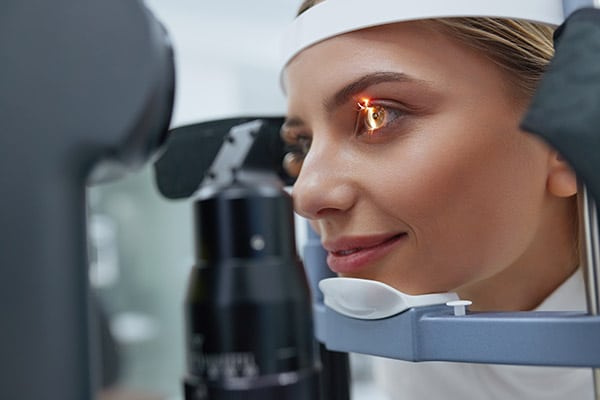Low Vision

Low vision is technically defined as someone who has 20/60 vision or worse in their better-seeing eye, or their field of view is severely constricted. Neither one of these restrictions cannot be improved upon with glasses or contact lenses. With mild low vision problems, the patient typically cannot read with conventional glasses, or their prescription cannot be adjusted to see at distance adequately. In more severe cases, the patient can lose their sense of independence because they can no longer read normal-sized print at all, or they have great difficulty caring for themselves. Low vision does not discriminate when it comes to age.
There are many causes that can lead to low vision. The more typical diseases that are attributed to permanent visual impairment are macular degeneration, diabetes, and Glaucoma. Of course, there is a myriad of other ocular conditions that can hamper one’s sight such as retinitis pigmentosa, trauma, and strokes just to name a few.
The most important step for a low vision patient is to get their underlying condition properly diagnosed and treated. There needs to be an attempt made at controlling the disease before seeking a low vision evaluation.
The low vision exam entails first and foremost thorough refraction to determine if a patient’s corrective eyewear is appropriate. Then the patient’s specific individual needs are assessed. Low vision equipment tends to be very task-specific, so it is very important to match the appropriate equipment with the activity the patient wishes to accomplish. Reading, for example, might require one particular device, whereas watching television would usually entail the use of a completely different one. The patient’s lifestyle needs are also analyzed since certain recommendations can sometimes make even the most menial task much easier.
Low vision equipment comes in many forms. It may entail some very high powered glasses in which the patient has to hold a book a mere four inches away. If this sort of device seems impractical to the patient, then their needs might be better served with a hand-held magnifier or a video magnifier. There is also a large selection of tools to help patients improve their distance vision. All of these can be viewed at the time of the evaluation.
Many times proper medical management and a low vision evaluation can set the course towards restoring a patient’s independence. Quite often, merely regaining the ability to read your email or tending to your bills can make a world of difference when it comes to self-esteem. Low vision is technically defined as someone who has 20/60 vision or worse in their better-seeing eye, or their field of view is severely constricted. Neither one of these restrictions cannot be improved upon with glasses nor contact lenses. With mild low vision problems, the patient typically cannot read with conventional glasses, or their prescription cannot be adjusted to see at distance adequately. In more severe cases, the patient can lose their sense of independence because they can no longer read normal-sized print at all, or they have great difficulty caring for themselves. Low vision does not discriminate when it comes to age.
There are many causes that can lead to low vision. The more typical diseases that are attributed to permanent visual impairment are macular degeneration, diabetes, and glaucoma. Of course, there is a myriad of other ocular conditions that can hamper one’s sight such as retinitis pigmentosa, trauma, and strokes just to name a few.
The most important step for a low vision patient is to get their underlying condition properly diagnosed and treated. There needs to be an attempt made at controlling the disease before seeking a low vision evaluation.
The low vision exam entails first and foremost thorough refraction to determine if a patient’s corrective eyewear is appropriate. Then the patient’s specific individual needs are assessed. Low vision equipment tends to be very task-specific, so it is very important to match the appropriate equipment with the activity the patient wishes to accomplish. Reading, for example, might require one particular device, whereas watching television would usually entail the use of a completely different one. The patient’s lifestyle needs are also analyzed since certain recommendations can sometimes make even the most menial task much easier.
Low vision equipment comes in many forms. It may entail some very high powered glasses in which the patient has to hold a book a mere four inches away. If this sort of device seems impractical to the patient, then their needs might be better served with a hand-held magnifier or a video magnifier. There is also a large selection of tools to help patients improve their distance vision. All of these can be viewed at the time of the evaluation.
Many times proper medical management and a low vision evaluation can set the course towards restoring a patient’s independence. Quite often, merely regaining the ability to read your email or tending to your bills can make a world of difference when it comes to self-esteem.

